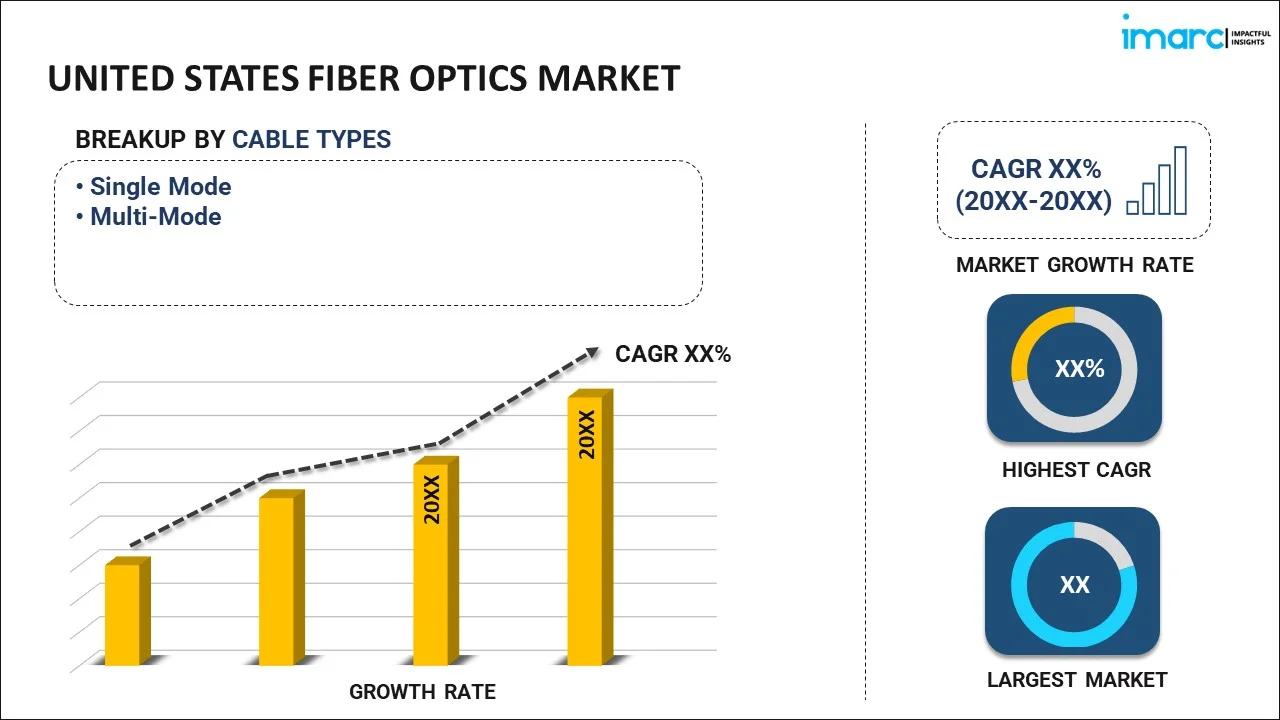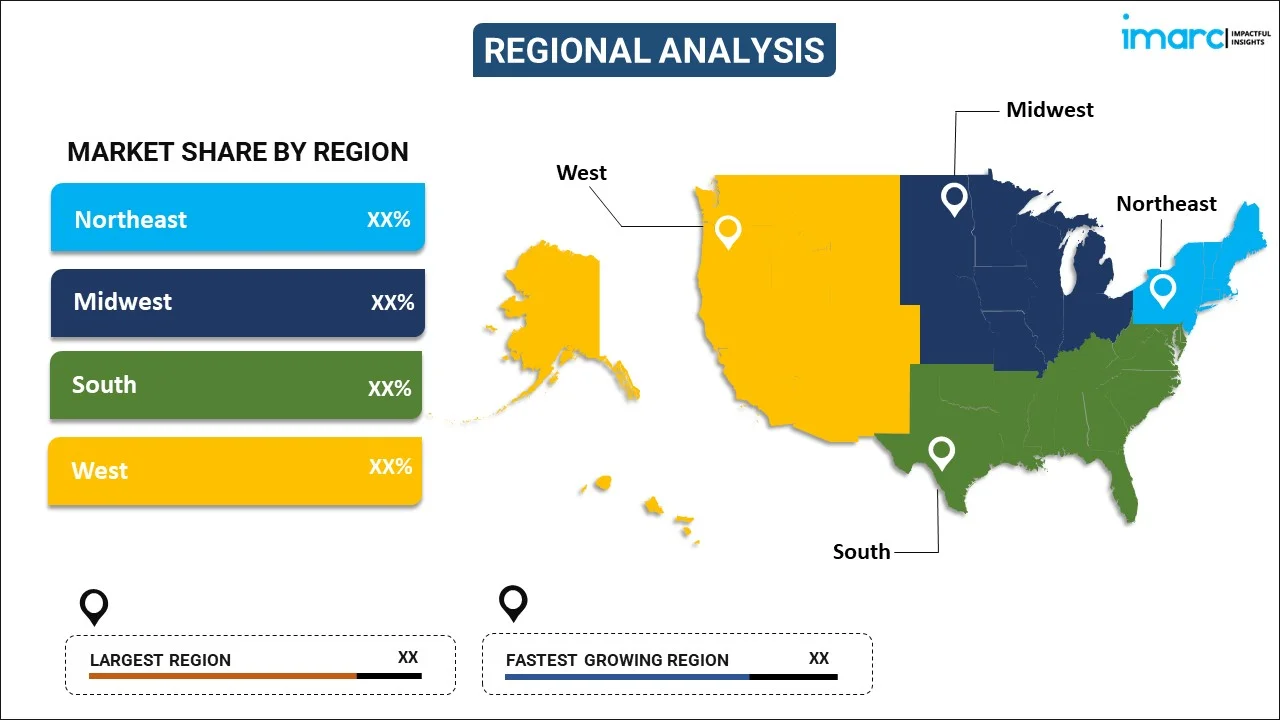
United States Fiber Optics Market Report by Cable Type (Single Mode, Multi-Mode), Optical Fiber Type (Glass, Plastics), Application (Telecom, Oil and Gas, Military and Aerospace, BFSI, Medical, Railway, and Others), and Region 2025-2033
Market Overview:
The United States fiber optics market size reached USD 3.1 Billion in 2024. Looking forward, IMARC Group expects the market to reach USD 7.8 Billion by 2033, exhibiting a growth rate (CAGR) of 10.8% during 2025-2033. The increasing demand for high-speed internet by consumers, the implementation of favorable initiatives to promote the expansion of fiber optics networks, the advent of fifth-generation (5G) technology, and the rising Internet of Things (IoT) ecosystem represent some of the key factors driving the market.
|
Report Attribute
|
Key Statistics
|
|---|---|
|
Base Year
|
2024
|
|
Forecast Years
|
2025-2033
|
|
Historical Years
|
2019-2024
|
|
Market Size in 2024
|
USD 3.1 Billion |
|
Market Forecast in 2033
|
USD 7.8 Billion |
| Market Growth Rate 2025-2033 | 10.8% |
Fiber optics is an advanced technology that transforms the way data is transmitted over long distances. They involve the use of thin strands of glass or plastic, known as optical fibers, to transmit information in the form of light pulses which is gaining significant traction in recent years due to its incredible speed, reliability, and efficiency. They rely on total internal reflection, where light rays are continually reflected within the core of the optical fiber, allowing them to travel great distances without significant loss of signal strength, which makes fiber optics ideal for transmitting data over vast networks, including the internet, telecommunications, and cable television. They offer exceptional data transfer speeds and use light to carry information, which allows for data transmission at nearly the speed of light, resulting in blazing-fast internet connections and minimal latency. Additionally, whether an individual is streaming high-definition videos, engaging in video conferencing, or downloading large files, fiber optics ensures a seamless and uninterrupted experience. It also offers unparalleled reliability even in challenging environmental conditions, such as heavy rain or electromagnetic interference, the integrity of the data transmission remains intact. Consequently, fiber optics is known for its efficiency and consumes less energy compared to traditional copper cables, making it an environmentally friendly choice while reducing operational costs and sustainability goals.
United States Fiber Optics Market Trends:
The market is primarily driven by the increasing demand for high-speed internet by consumers. In addition, the rising demand for high-speed internet for various activities such as remote work, online education, and streaming is increasing the need for faster and more reliable internet connections, thus contributing to the market growth. Fiber optics can transmit data at incredible speeds and are becoming the go-to choice for meeting this demand. Moreover, governments are recognizing the importance of enhanced digital infrastructure and taking various initiatives to promote the expansion of fiber optics networks, representing another major growth-inducing factor. Besides this, several investment programs, tax incentives, and grants are rolled out to encourage the deployment of high-speed broadband in underserved and rural areas, which have incentivized service providers to expand their fiber optics networks, thus accelerating the market growth. Along with this, the rising demand for fiber optics due to its immense bandwidth capacity and durability is propelling the market growth. Also, the advent of fifth-generation (5G) technology and the rising Internet of Things (IoT) ecosystem are escalating the demand for higher bandwidth and low-latency connections, thus augmenting the market growth. Furthermore, the growing environmental consciousness led to the adoption of fiber optics, which consumes less energy, produces minimal electromagnetic interference, and has a longer lifespan, thus creating a positive market outlook.
United States Fiber Optics Market Segmentation:
IMARC Group provides an analysis of the key trends in each segment of the market, along with forecasts at the country level for 2025-2033. Our report has categorized the market based on cable type, optical fiber type, and application.
Cable Type Insights:

- Single Mode
- Multi-Mode
The report has provided a detailed breakup and analysis of the market based on the cable type. This includes single mode and multi-mode.
Optical Fiber Type Insights:
- Glass
- Plastics
A detailed breakup and analysis of the market based on the optical fiber type have also been provided in the report. This includes glass and plastics.
Application Insights:
- Telecom
- Oil and Gas
- Military and Aerospace
- BFSI
- Medical
- Railway
- Others
The report has provided a detailed breakup and analysis of the market based on the application. This includes telecom, oil and gas, military and aerospace, BFSI, medical, railway, and others.
Regional Insights:

- Northeast
- Midwest
- South
- West
The report has also provided a comprehensive analysis of all the major regional markets, which include Northeast, Midwest, South, and West.
Competitive Landscape:
The market research report has also provided a comprehensive analysis of the competitive landscape. Competitive analysis such as market structure, key player positioning, top winning strategies, competitive dashboard, and company evaluation quadrant has been covered in the report. Also, detailed profiles of all major companies have been provided. Some of the key players include:
- Coherent Corp
- Corning Inc.
- Leoni AG
- Molex LLC (Koch Industries)
- Nexans
- Smiths Interconnect
- Sumitomo Corporation
- Weinert Industries AG
(Please note that this is only a partial list of the key players, and the complete list is provided in the report.)
United States Fiber Optics Market Report Coverage:
| Report Features | Details |
|---|---|
| Base Year of the Analysis | 2024 |
| Historical Period | 2019-2024 |
| Forecast Period | 2025-2033 |
| Units | Billion USD |
| Scope of the Report | Exploration of Historical and Forecast Trends, Industry Catalysts and Challenges, Segment-Wise Historical and Predictive Market Assessment:
|
| Cable Types Covered | Single Mode, Multi-Mode |
| Optical Fiber Types Covered | Glass, Plastics |
| Applications Covered | Telecom, Oil and Gas, Military and Aerospace, BFSI, Medical, Railway, Others |
| Regions Covered | Northeast, Midwest, South, West |
| Companies Covered | Coherent Corp, Corning Inc., Leoni AG, Molex LLC (Koch Industries), Nexans, Smiths Interconnect, Sumitomo Corporation, Weinert Industries AG, etc. (Please note that this is only a partial list of the key players, and the complete list is provided in the report.) |
| Customization Scope | 10% Free Customization |
| Post-Sale Analyst Support | 10-12 Weeks |
| Delivery Format | PDF and Excel through Email (We can also provide the editable version of the report in PPT/Word format on special request) |
Key Questions Answered in This Report:
- How has the United States fiber optics market performed so far and how will it perform in the coming years?
- What has been the impact of COVID-19 on the United States fiber optics market?
- What is the breakup of the United States fiber optics market on the basis of cable type?
- What is the breakup of the United States fiber optics market on the basis of optical fiber type?
- What is the breakup of the United States fiber optics market on the basis of application?
- What are the various stages in the value chain of the United States fiber optics market?
- What are the key driving factors and challenges in the United States fiber optics?
- What is the structure of the United States fiber optics market and who are the key players?
- What is the degree of competition in the United States fiber optics market?
Key Benefits for Stakeholders:
- IMARC’s industry report offers a comprehensive quantitative analysis of various market segments, historical and current market trends, market forecasts, and dynamics of the United States fiber optics market from 2019-2033.
- The research report provides the latest information on the market drivers, challenges, and opportunities in the United States fiber optics market.
- Porter's five forces analysis assist stakeholders in assessing the impact of new entrants, competitive rivalry, supplier power, buyer power, and the threat of substitution. It helps stakeholders to analyze the level of competition within the United States fiber optics industry and its attractiveness.
- Competitive landscape allows stakeholders to understand their competitive environment and provides an insight into the current positions of key players in the market.
Need more help?
- Speak to our experienced analysts for insights on the current market scenarios.
- Include additional segments and countries to customize the report as per your requirement.
- Gain an unparalleled competitive advantage in your domain by understanding how to utilize the report and positively impacting your operations and revenue.
- For further assistance, please connect with our analysts.
 Inquire Before Buying
Inquire Before Buying
 Speak to an Analyst
Speak to an Analyst
 Request Brochure
Request Brochure
 Request Customization
Request Customization




.webp)




.webp)












